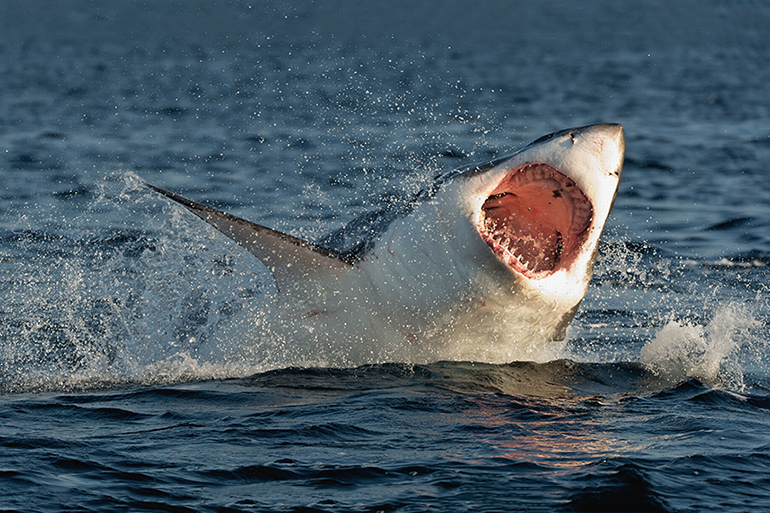The Real Montauk Monster: Frank Mundus' Killer Shark the Size of a Car

It’s true that Montauk holds more deep sea fishing records than any other port in the world. But the record for the largest fish ever caught on rod and reel has eluded it. That record remains a 2,664-pound shark caught by a fisherman out of Adelaide, Australia in 1959.
Nevertheless, if you go down to the Clam and Chowder House at Salivar’s Dock today, you will see, high up on the wall, the enormous head of a killer shark, its jagged teeth exposing a hideous grin, that had once been attached to a shark that weighed as much as a car—3,427 pounds—and which was reeled in on tackle that would break if it were stressed to an amount greater than 100 pounds. It was caught by a Montauk fisherman and reeled in 30 miles southeast of Montauk in early August, 1986. It should have broken the record, but didn’t.
This shark was disqualified by a representative from the International Game Fish Association, who came up to Montauk a few days after the fish was caught to review the claim. He’d read an article I’d written in Dan’s Papers about how this fish got caught. I’d written it in detail.
I didn’t know that one particular detail I wrote about would disqualify the catch. Neither did Captain Frank Mundus, who captained the boat that caught it and told me how he did it, there out on the dock the night the fish was brought ashore.
Later, after everything blew over, Mundus told me he forgave me. “You couldn’t know,” he said. “Neither could I.” The Australian entry is still unchallenged to this day.

On the Sunday afternoon of August 8, 1986, Captain Mundus took four New York City fishermen aboard his Cricket II deep-sea shark fishing boat. These men were serious fishermen who’d paid Mundus $1,500 to be out there for a full 24 hours. They were not expecting to catch anything the size of an automobile. They were after sharks that would weigh on the order of 200 or 300 pounds each. That was the plan.
On Monday morning, 30 miles off Montauk, Mundus came upon the floating carcass of a 55-foot dead whale. Herds of sharks were feeding on this whale. It occurred to Mundus that a giant might be among them.
Mundus talked to the businessmen. He wanted to stay near to that dead whale through to Tuesday evening if needed. He sensed the giant. He’d extend the charter, for free, just to stay with him.The businessmen talked it over and told Mundus they appreciated the offer but had to get back to their businesses in Manhattan. So Mundus radioed to a nearby charter boat to come alongside, pick them up and take them in. He was staying.
The following afternoon, he saw what he was looking for. A great white was dining on the whale, going off and then coming back. He’d try to hook this shark with 100-pound test line. A fight of up to six hours would be possible. This was a problem. He was 60 years old and knew his limits. “I’m no spring chicken,” he told me back on the dock. He’d need a young “damn fool” to do the fight. And he knew where there was one.
“I’d been in radio contact with Donnie Braddick of the Fish On, nearby looking for tuna. He’s 30. I called him, told him where I was, what it was all about and asked him if he’d like to come over.”
Donnie Braddick saw this as a once-in-a-lifetime opportunity. He’d be the damn fool. He motored over and they lashed the two boats together. Captain Mundus played out his fishing line with butterfish and whiting disguising the hooks. And they waited.
I asked Mundus the obvious question. How do you reel in a 3,500-pound fish on 100-pound line?
“You don’t,” he said. “You just catch him on the line. And then you chase him around the ocean with the boat and you tire him out.”
I told Mundus I thought this was terrifying.
“Finally, you pull up alongside him in your boat—you find a time when he is resting comfortably up on the surface—and you hit him in the tail with your gaff hook, and then you lasso him with a rope.”
“What if he wakes up?”
“That’s the thing. If he does, you’re dead.”
“And how do you kill him?”
“By dragging him home backwards. The water goes up into his gills the wrong way. He suffocates after a time.”
“Oh.”
The Cricket II was only 42 feet long. The fish he dragged home would be lashed to the side, heeling the ship way over. It wouldn’t be easy, but it could be done if you went slow.
Mundus sat in the fighting chair, ordered Braddick up to the wheelhouse to pilot the Cricket II and shouted up to him to go this way and that. He’d use his 30 years of experience to get the monster to take the bait. An hour went by, and then…he bit.
“As soon as he took the hook, I called to Braddick to come down and get in the chair. He’d bring him in. It would be his fish. We changed places.”
Over the marine radio, Mundus called Captain Carl Darenberg of the Montauk Marine Basin to tell him what was going on. Darenberg told Mundus he’d stay at his desk, available for further conversations, and then called his wife to say he wouldn’t be home for dinner.

By 11 p.m. that night, more than 1,000 people including this reporter, were down at the docks, hoping to get a glimpse of Mundus coming through the jetties. He was taking his time. We waited for hours. Car headlights were turned on the jetty. Finally, the Cricket II came through at a slow four knots, leaning way over to starboard with the weight of the shark lashed there. It was quite a sight.
Lit by other car headlights at the dock, a yellow forklift tried to raise the fish, but it was so long the forklift could not get it completely out of the water. A construction crane was brought in, and, after using it to slide a heavy cargo net under the shark, they were able to lift it up and place it atop a big scale that could weigh things up to 3,500 pounds.
The giant lay there, its tongue hanging out one side of its mouth, its twin rows of teeth glistening. The needle went up to 3,500 and hovered there. Deducting the 72 pounds for the net, the Marine Basin announced its weight at 3,427 pounds. Pictures were taken.
The fish lay on the dock for the next 24 hours, during which time reporters and newscasters from CBS, ABC, The New York Times and the national media came out to tell the story, as did scientists from the Museum of Natural History, National Marine Fisheries Service and the International Game Fish Association.
Dan’s Papers was published. I had written what Mundus had told me.
“The monster took the hook around 4:30 in the afternoon with Mundus in the chair. Mundus immediately got up. Braddick sat down and the fight was on…”
And that’s what disqualified this catch. From start to finish, the catching of the fish had to be done with just one fisherman in the fighting chair. And it wasn’t.
Years later, Lou Russo, a columnist for the Fisherman’s Weekly, wrote “(This incident reported in Dan’s Papers) was the likely reason the IGFA did not approve the record. A record 547 kg shortfin mako catch by Jody Daniels on the Hustler captained by Glen Hodson on March 2, 1990, was disqualified for the same reason.”
I told a friend this story.
He thought about it. “You should kill yourself,” he said.



